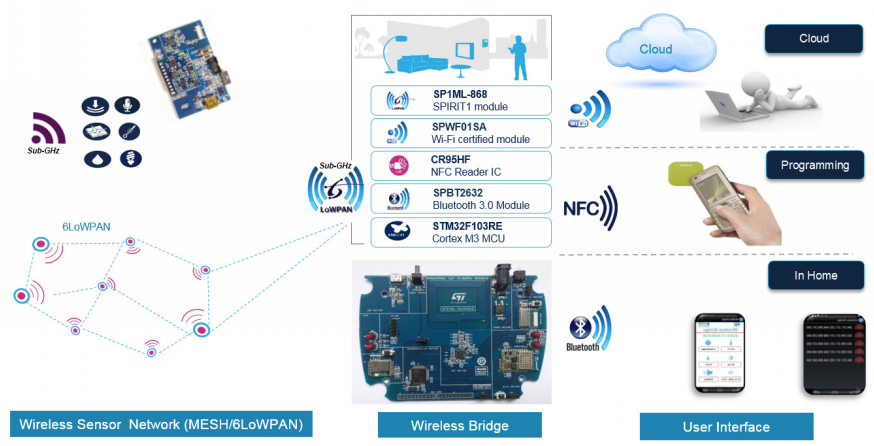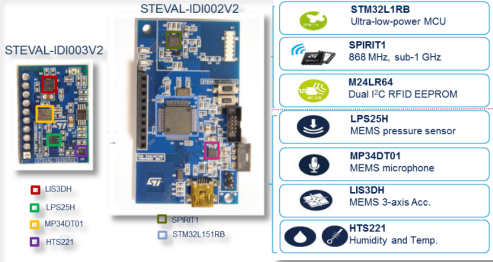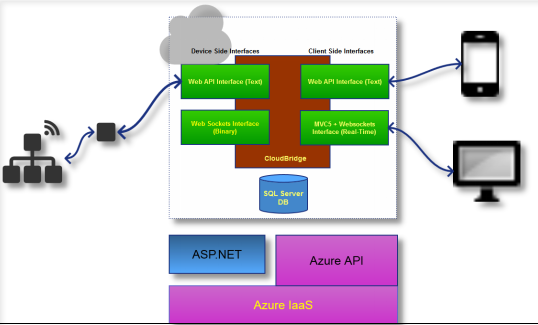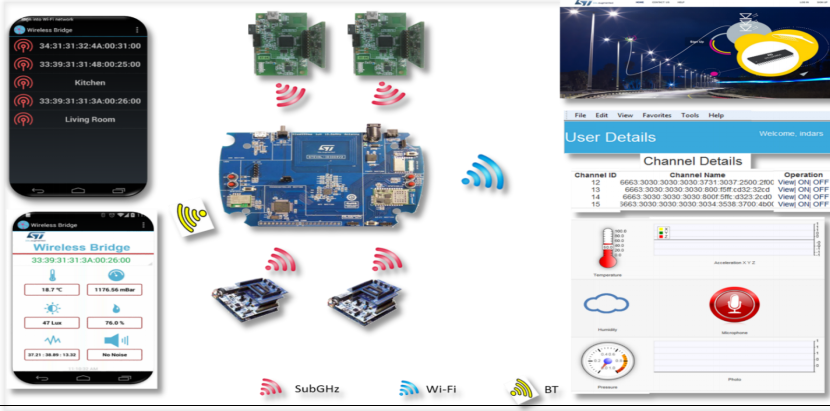IoT Gateway Design Challenge
Node connection: Connect the gateway to the Internet of Things node, need to use a close-range radio frequency (RF) communication technology. When selecting RF technology, it is necessary to compare various parameters such as frequency band, modulation method, channel number, data rate, delay, robustness and so on. In addition, we should also consider the relevant provisions of the local industry regulations. If the same type of node isomorphic network, RF technology selection is relatively easy. On the contrary, if there are many different nodes in the network, there are different needs, RF selection will be a lot of complex.
Management Server: The Internet of Things node, as a separate entity, typically does not accept access requests from network devices (through gateways). The more common practice is to manage the network nodes through the central server, and the IoT gateway provides communication support for the server, so we need to select the communication protocol between the gateway and the management server.
Local intelligence: In the real cloud architecture, the node will send all the data to the cloud for processing and control. However, this setting is not ideal, because the value of the data will be sent to the cloud server, resulting in waste of bandwidth, server load increases, even when the connection will lose data. The edge computing concept solves this problem. If the IoT gateway takes on most of the local decision-making, only the valuable data will be sent to the cloud, and the system will become more efficient. For the sake of flexibility, the gateway decision logic can be set by the server. Local intelligence and type depends on the practical application, if it will affect the gateway design decisions, should be given in-depth consideration.
The power factor to consider: Gateway power also affects our design. Because it is widely used in Internet equipment, so the sensor network should be as much as possible from the environment to draw energy.
Data security: This is the key factor in determining the success or failure of large-scale Internet of Things. Data security becomes more important as the network becomes an important part of more applications (some applications are actually critical applications). Security issues should be implemented at each design stage, and it is wrong to add security features after all the design tasks are completed.
Maintainable: This is a often overlooked demand. Historical experience tells us that no system is perfect. No matter how many tests have been done before deployment, you will find security flaws, pitfalls and vulnerabilities after deployment. IoT gateways and nodes must support on-site maintenance and update functions. Equipment maintenance should not only rely on remote maintenance, there should be more networking options.
Below we discuss in detail the existing networking technology, and each connection technology can be used for what the scene.
Node connection technology
At present, Bluetooth, Wi-Fi, NFC, ZigBee is very familiar with the wireless communication technology. In addition, emerging networking technologies such as Sub GHz, Thread, ANT, Z-Wave can be used directly for smart homes, smart cities, smart lighting and smart meters. According to the actual application, power consumption, data rate, operating frequency, battery life is to decide which one or some of the main factors of networking technology. Table 1 below compares the characteristics of today's major wireless communications technologies.
Background connection
The connection between the gateway and the management server (background) requires the selection of the backhaul connection technology and the communication protocol. The backhaul connection is a remote connection between the IoT gateway and the ISP's Internet service provider endpoint. 2G / 3G / LTE and other mobile communication technology is the hottest backhaul link technology. In addition, intelligent street lights and other applications can also use power line communication (PLC) technology. High-bandwidth applications can use fiber-optic communication technology. Remote areas that are not covered by mobile networks can use satellite communications or microwave point-to-point connectivity.
letter of agreement
There are many communication protocols available for communication between the IoT gateway and the cloud server. Here we discuss some of the more popular technology and its advantages and disadvantages.
Plain HTTP: This is the most widely used network protocol, widely accepted by server vendors, supported by Internet standards, with minimal compatibility issues and seamless support for RESTful APIs. However, the shortcomings of this technology is too much overhead, reflected in the HTTP header and text-based format. Plain HTTP running on top of TCP, but still a stateless protocol, not suitable for instant messaging applications. The client must send a request signal to receive the server's response (command). In order to receive updates to the server, the client must continuously poll the server.
CoAP: resource-constrained application protocol, which can be considered a binary version of HTTP, has made some improvements to the HTTP protocol, has a very accurate header, supports binary data format, thus reducing overhead; can run on TCP or other Transport layer or even SMS above. CoAP packets are easily converted to HTTP packages. However, because of the lack of support for the Internet infrastructure, this technology is not well compatible with firewalls, proxy servers and routers. Therefore, this protocol is usually only applicable to the private network within the sensor network.
Web sockets: This is a new Internet protocol that supports Internet standards, using the same addressing and handshaking methods as HTTP, compatible with existing network infrastructure. After the completion of the handshake dialogue, immediately converted to TCP above the duplex communication, suitable for real-time two-way communication, especially for the host to share the virtual host environment and proxy server behind the gateway.
MQTT: is also a popular market running on the TCP layer (optional) network protocol, there is a theme subscription mode, more suitable for the relevant gateway to broadcast information, but also for the gateway and server communications, with some The function of the networking application, for example, the last message permanent and the will message.
AMQP: This is perhaps the most suitable network protocol for gateway and server communication. The effect of the protocol is equivalent to a storage queue, even if the temporary network, but also to ensure that the packet will not be lost.
XMPP: Extensible messaging and field protocols, which are widely used by chat clients, are standardized on many functions, such as user authentication and message IDs. However, because the technical specifications are very complex, data exchange using lengthy XML format, it is not suitable for Internet applications.

IoT Gateway Platform Architecture
Here we introduce a self-developed flexible variable sensor data monitoring design. Sensor data monitoring is a common application, there is no special requirement for safety or reliability.
Wireless bridge IoT gateway: Wireless bridge is based on STM32 IoT gateway platform program, providing a variety of different communication connection technology, as shown in Figure 1. The communication system consists of Bluetooth, Wi-Fi, Sub-GHz and NFC short-range communications. Each communication technology has its own advantages. Wi-Fi is used to transfer objects or node data between the gateway platform and the cloud platform, Bluetooth is used for exchanging objects or node data between the gateway platform and the Android application, and Sub-GHz technology is used to communicate with the object or node To transfer data between. On the wireless bridge platform, Bluetooth, Wi-Fi and Sub-GHz modules communicate with the STM32 via the UART line, while the NFC transceiver communicates with the STM32 via the SPI cable. How can the STM32 microcontroller be used with different communication devices Delay, and efficient processing of all requests, is a major challenge for this platform design. This gateway platform architecture can help us use different communication technologies to meet different use case requirements. We add an application layer to this gateway scheme, acting as a bridge between the cloud application and the object. The operating system for this 6LoWPAN network is the Contiki OS. The mobile application communicates with the gateway through the Bluetooth interface.
Main communication components
Sub-GHz module: The gateway communicates with the "substance" in the 6LoWPAN network via the SPIRIT1 Sub-GHz module. The SPIRIT1 module is an ultra-low power, highly integrated RF module that supports the 868 MHz / 915 Mhz ISM dual-band operation. The module is based on the SPIRIT1 RF sub-GHz transceiver (built-in SMPS power supply), the STM32L1 microcontroller, and the internal filter / balanced unbalanced converter chip antenna. The UART host interface can be connected directly to an external microcontroller via a standard firmware library, simplifying RF configuration and data transmission using point-to-point communication and AT commands.
Wi-Fi module: The Wi-Fi module connects the wireless bridge gateway to the cloud application. The SPWF01Sx Smart Wi-Fi module is a stand-alone plug-and-play 802.11 b / g / n solution with built-in power amplifier and 32-bit STM32 microcontrollers. The module also integrates clock chips and regulators.
Short-range communication: The gateway platform uses the CR95HF transceiver as an NFC read / write device and communicates with the NFC passive tags on the "objects" to configure the device. CR95HF is a 13.56-MHz multi-protocol, non-contact transceiver.
Bluetooth module: SPBT2632Cxx Bluetooth module is a small size function of the completion of the RF platform for home automation equipment and Bluetooth devices and mobile phone data transfer between.
Material structure
In this solution, there are two components (STEVAL-IDI002V2 and STEVAL-IDI003V2) based on the multi-sensor-RF platform. STEVAL-IDI002V2 is the motherboard, integrated STM32L1 Cotex-M3 microcontroller, dual interface EEPROM and Sub Ghz communication interface. STM32L1 runs a 6LoWPAN protocol stack based on Contiki3x. Select this microcontroller is taking into account the requirements of ultra-low power consumption. The dual interface EEPROM enables the multi-sensor RF platform to store the data sent by the sensor so that the user can choose to view the data on the NFC handset.

Figure 2: RF sensor node (object)
In the 6LoWPAN network, the multi-sensor radio frequency platform is 'material', Sub-GHz radio module on the wireless bridge (gateway) is the root node. The sensor node reads the sensor data and sends it to the root node via the 6LoWPAN network. The sensor node also has a GPIO port for controlling the actuator. The IoT gateway provides local and remote connectivity options to access sensor data and actuators on nodes.
Web Access: Remote users can use the Web interface provided by the management server to view sensor data and send commands to the actuator.
Andrews application software: local users can use Bluetooth mobile phone to access the node. After the completion of the mobile phone and wireless bridge platform paired, the mobile application software can use the node function.
NFC support: wireless bridge support NFC read and write functions. This communication function can be used to configure nodes (radio frequency channels, etc.) and gateways (Wi-Fi and Bluetooth settings, etc.).
Management server application design
We also designed a cloud application called ST Cloud Bridge to set up an interactive bridge between the built-in sensor / actuator or the node and the end user. Figure 3 is a block diagram of the cloud application. Object or node to upload data to the ST Cloud Bridge cloud application, and then get the command and configuration information. The end user can monitor the sensor data stream and set a reminder notification for various situations. The platform also opens, controls and configures nodes. The Cloud Bridge cloud application consists of two components: the device module and the web module. The device module interacts with the sensor / actuator node, while the web module handles the web client and the mobile client used by the user. These two modules interact with the shared object or cloud service bus, which runs on the Azure website platform, provides data security capabilities, and interacts with registered nodes only, so data integrity will not be affected. The cloud application allows "objects" to use REST-based standard APIs through gateways.For the Internet of Things management applications, it is important to support multiple protocols. We must have a device management module, a monitoring module, a reporting module, and a module.
Considering the inherent load variability of Internet of Things applications, IaaS is the preferred way for enterprise hosting cloud applications. Now a lot of cloud service providers began to provide Internet of special services, so that the development and maintenance of Internet of Things applications become more convenient.

Internet of Things applications
Home automation
Smart home: These applications allow users to remotely monitor security equipment and appliances, and can also improve energy efficiency, for example, when the user goes out, automatically turn off the appliance.
Smart City: Intelligent streetlight: By monitoring ambient light and traffic flow and other parameters, municipal managers can control the brightness of street lamps and switch lights, saving a lot of power. If the street lights fail, the system will immediately repair, reduce the risk of accident or crime rate.
Smart meter: wireless connection meter can achieve remote meter reading and some applications, such as ladder-type electricity and two-way metering energy meter. Smart meters can detect and report stealing, circuit leakage and other events.
Intelligent parking lot: Intelligent parking lot based on proximity detection sensor is another kind of networking application, which can send empty parking information to the driver in advance, avoid traffic congestion problem, and make the parking time charge more accurate.
Wisdom Agriculture: Through accurate monitoring of humidity and nutrition, the system can suggest watering and fertilization time, thus saving water and fertilizer costs, while significantly increasing production. Practice has proved that when used in conjunction with weather forecasts, the system allows farmers to effectively benefit.
health
This is the upcoming Internet of Things application, will give end users a healthy change in health care. A variety of wear sensors to collect the patient's body temperature, blood pressure and other important physiological parameters, and then sent through the IoT gateway to the patient online health files for the user to establish an accurate physiological parameters file. For health care professionals, the data associated with the history of the disease is an effective diagnostic tool that can analyze the data in real time and, in case of emergency, can act quickly and immediately rescue the patient.
industry
In the monitoring and optimization of industrial production process, the Internet of Things can also play an important role. The advent of low-power sensor nodes opens up a new way in the field of industrial automation. Low-power sensor nodes in the past or a small challenge, in addition to industrial automation applications, but also into the human harmful or can not enter the dangerous environment instead of human work.
in conclusion
We have proposed a common IoT gateway platform that can connect "objects" in 6LoWPAN networks and support mobile and cloud applications. The gateway that is connected is the IoT wireless gateway in the IPv6 network. The system solution can be customized to suit different use cases. The emergence of high quality open source grid networking protocols, for example, Contiki, helps Harvatek Internet of Things to accelerate into the consumer space. For all Internet of things applications, security is still a challenging issue, which does not need to say. Although the existing security technology can hold, but with the universal popularity of things, we will find more security challenges. The industry is still trying to find a better low-cost / low-power solution to build a secure Internet of things. Semiconductor process progress, cost reduction, better power management technology and energy recovery technology will open the door for the Internet of Things another door.






